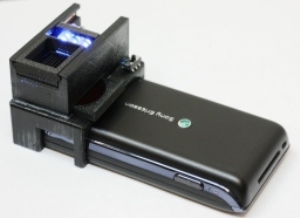A team of researchers from the UCLA Henry Samueli School of Engineering and Applied Science have created a fluorescent imaging platform capable of detecting the bacterium Escherichia Coli in water in food. The novel cell phone-based sensor is a compact and lightweight attachment that can be fixed to any cell-phone camera.
 Cell phone based E.Coli detector
Cell phone based E.Coli detector
The researchers combined quantum dots and antibody functionalized glass capillaries that function as signal reporters specifically for detecting E. coli in liquids. The researchers excited labeled E.Coli particles present on a capillary surface by using inexpensive, battery-powered light-emitting diodes. The cell phone cameras can capture emissions from quantum dots, using a lens inserted between the cell phone and the capillary surface.
The cell phone attachment functions as a florescent microscope which quantifies the emitted light from the capillaries individually after capturing the E. coli particles. The concentration of the bacteria present in the sample can be defined by quantifying the emitted florescent light.
The bacterium E. coli is known to contaminate both drinking water and food. It poses threat to public health even in developed countries and is responsible for a large number of deaths and hospitalizations annually. Fewer than 100 E. coli particles can destroy the human kidneys, the cells in the intestinal lining, cause blood clots in the human brain as well as cause paralysis, seizures and respiratory failure.
This study demonstrates the promising potential of a cost-effective and field-portable E. coli detection platform for screening of food and water samples.
The research group is funded by the National Institutes of Health, the US Army Research Office, the US Office of Naval Research and the National Science Foundation.